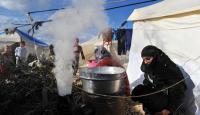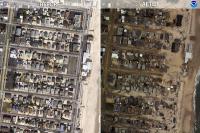-
Syria’s civil war, Europe’s refugee crisis the result of spikes in food prices: Experts

The disintegration of Syria and Europe’s refugee crisis are only the latest tragic consequences of two spikes in food prices in 2007-08 and 2010-11 that triggered waves of global unrest, including the Arab Spring. Researchers have traced these spikes and spiraling crises to their root causes: deregulated commodity markets, financial speculation, and a misguided U.S. corn-to-ethanol fuel policy which removes nearly five billion bushels of corn from markets each year.
-
-
PNNL to help DHS address critical infrastructure vulnerabilities
The Department of Energy’s Pacific Northwest National Laboratory (PNNL) has been named a supporting laboratory to the National Infrastructure Simulation and Analysis Center (NISAC). NISAC is a Department of Homeland Security (DHS) program which addresses the potential vulnerabilities and consequences of disruption of U.S. critical infrastructure. PNNL says it will contribute advanced computer modeling and simulation capabilities to look at the dependencies, interdependencies, vulnerabilities, and complexities of important critical infrastructure sectors such as dams, water, transportation, energy, and information technology.
-
-
FEMA funding for post-Sandy recovery in New Jersey exceeds $6.8 billion

In the three years since Hurricane Sandy scored a direct hit on New Jersey, FEMA has provided $6.8 billion to date to help the state recover and rebuild. FEMA Public Assistance, which provides funds for repair and rebuilding of infrastructure and public facilities as well as necessary work such as debris removal and emergency response, has obligated $1.809 billion in Public Assistance funds towards repair and rebuilding projects in New Jersey.
-
-
Study: Persian Gulf could experience deadly heat
Detailed climate simulation shows that the Persian Gulf region would likely cross the threshold of survivability unless mitigation measures are taken. That tipping point involves a measurement called the “wet-bulb temperature” which combines temperature and humidity, reflecting conditions the human body could maintain without artificial cooling. That threshold for survival for more than six unprotected hours is 35 degrees Celsius, or about 95 degrees Fahrenheit, according to recently published research (the equivalent number in the National Weather Service’s more commonly used “heat index” would be about 165 F). The researchers say that hot summer conditions that now occur once every twenty days or so “will characterize the usual summer day in the future.”
-
-
Deadly extreme weather events to intensify, become more frequent over the next 50 years
European heat wave of 2003, during which 35,000 people died. It was the most extreme event of its kind since 1500 AD. In May 2015, India was struck by a severe heat wave that killed more than 2,500 people. “Heat waves that [were once] expected to occur twice a century [are now], in the early 2000s, expected to occur twice a decade. Human influence has very likely at least doubled the likelihood of such an event,” says one expert.
-
-
FEMA aid for New York’s Hurricane Sandy recovery reaches $16.9 billion
FEMA and the U.S. Small Business Administration have disbursed nearly $16.9 billion for New York’s recovery since Hurricane Sandy made landfall on the East Coast three years ago. FEMA said that this amount includes more than $1 billion paid directly to survivors for housing and other essential needs through the Individuals and Households Program which ended 30 April 2014.
-
-
Concrete innovation makes Seattle skyscraper stable
All coupling beams in the 1.5 million-square-foot Lincoln Square Expansion — which includes luxury condos, a hotel, dining, retail and office space in two 450-foot towers in the heart of Seattle suburb Bellevue, Washington — are made of fiber-reinforced concrete using a unique design. These concrete coupling beams span doorways and windows, helping walls with such openings in them to function as a single structural unit, while bolstering the building as a whole against earthquakes. Traditionally, coupling beams are reinforced with a labyrinth of rebar, adding a great deal of time, cost and complexity to the construction process.
-
-
Tsunami-prone nations should follow Japan’s new approach to coastal defenses
Japan’s lead in implementing sea defense improvements to guard against future disasters is an important reference point for other tsunami-prone nations. In the wake of the March 2011 Fukushima disaster, Japan has drawn new engineering guidelines which have transformed Japan’s coastal defenses, and has devised new ways to keep its coastlines safe in the future. Other nations in known tsunami risk areas, however, have not yet followed suit.
-
-
Climate change will reshape global economy: Study
Unmitigated climate change is likely to reduce the income of an average person on Earth by roughly 23 percent in 2100, according to estimates contained in a new study. The findings indicate climate change will widen global inequality, perhaps dramatically, because warming is good for cold countries, which tend to be richer, and more harmful for hot countries, which tend to be poorer. In the researchers’ benchmark estimate, climate change will reduce average income in the poorest 40 percent of countries by 75 percent in 2100, while the richest 20 percent may experience slight gains.
-
-
September 2015, and January-September 2015, the warmest on record
A new report from the National oceanic and Atmospheric Administration (NOAA) finds that September 2015 was the warmest month on record, with average temperature across global land and ocean surfaces reaching 1.62°F (0.90°C) above the twentieth century average. The year-to-date temperature across global land and ocean surfaces was 1.53°F (0.85°C) above the twentieth century average. This was the highest for January–September in the 1880–2015 record.
-
-
U.S. should lead climate change fight to bolster global stability: U.S. defense, diplomacy leaders
Forty-eight former U.S. leaders, both Republicans and Democrats – among them secretaries of state and defense, national security advisers, leaders of the intelligence community, diplomats, generals in all four branches of the armed services, senators, and members of the House of Representatives – have published an open letter in the Wall Street Journal which called on U.S. political and business leaders to “think past tomorrow” and lead the fight on climate change. The U.S. security establishment has long recognized the threat posed by climate change to U.S. national security, defining climate change as a “threat multiplier,” adding fuel to conflicts. Security experts and military leaders no longer regard climate change as only a threat multiplier, but rather as s serious danger on its own – with droughts, sea-level rise, food shortages, and extreme weather events triggering migration and armed conflicts.
-
-
California’s future: More frequent and more severe droughts and floods
In the future, the Pacific Ocean’s temperature cycles could disrupt more than just December fishing. A new study suggests that the weather patterns known as El Nino and La Nina could lead to at least a doubling of extreme droughts and floods in California later this century.
-
-
Technology confronts disasters
In 2010, soon after Haiti was devastated by an earthquake, a team from MIT Lincoln Laboratory collected and analyzed information to help the U.S. Southern Command (USSOUTHCOM), the lead military agency responding to the crisis, effectively dispatch vital resources, including food, water, tents, and medical supplies, to the victims of this disaster. This Haiti experience demonstrated to Lincoln Laboratory researchers that advanced technology and technical expertise developed for the Department of Defense (DoD) can significantly benefit future humanitarian assistance and disaster relief efforts. In February, the Laboratory established the Humanitarian Assistance and Disaster Relief (HADR) Systems Group to explore ways to leverage or advance existing capabilities for improving disaster responses.
-
-
U.K. bolsters flood defenses
In 1953, more than 300 people died in the United Kingdom alone when heavy storms swept a high spring tide over sea defenses and across coastal towns in north-east England and Scotland. Today floods still make headlines but our ability to limit their effects has come a long way. Flooding costs the United Kingdom £2.2 billion a year in defenses and repairs, and annual spending must keep growing just to maintain present defenses. That is a massive investment, but history — and recent history at that — shows that the risk of flooding should not be underestimated.
-
-
Philippines coastal areas go underwater due to sea level rise
More than 167,000 hectares of Philippines coastland — about 0.6 percent of the country’s total area — are projected to go underwater in, especially in low-lying island communities, according to research by the University of the Philippines. Low-lying countries with an abundance of coastlines are at significant risk from rising sea levels resulting from global warming. According to data by the World Meteorological Organization, the water levels around the Philippines are rising at a rate almost three times the global average due partly to the influence of the trade winds pushing ocean currents. On average, sea levels around the world rise 3.1 centimeters every ten years. Water levels in the Philippines are projected to rise between 7.6 and 10.2 centimeters each decade.
-
- All
- Regional
- Water
- Biometrics
- Borders/Immig
- Business
- Cybersecurity
- Detection
- Disasters
- Government
- Infrastructure
- International
- Public health
- Public Safety
- Communication interoperabillity
- Emergency services
- Emergency medical services
- Fire
- First response
- IEDs
- Law Enforcement
- Law Enforcement Technology
- Military technology
- Nonlethal weapons
- Nuclear weapons
- Personal protection equipment
- Police
- Notification /alert systems
- Situational awareness
- Weapons systems
- Sci-Tech
- Sector Reports
- Surveillance
- Transportation
Advertising & Marketing: advertise@newswirepubs.com
Editorial: editor@newswirepubs.com
General: info@newswirepubs.com
2010-2011 © News Wire Publications, LLC News Wire Publications, LLC
220 Old Country Road | Suite 200 | Mineola | New York | 11501
Permissions and Policies
Editorial: editor@newswirepubs.com
General: info@newswirepubs.com
2010-2011 © News Wire Publications, LLC News Wire Publications, LLC
220 Old Country Road | Suite 200 | Mineola | New York | 11501
Permissions and Policies
